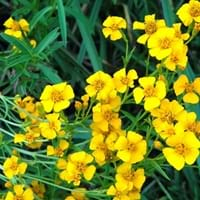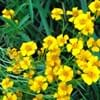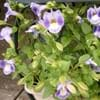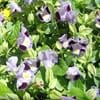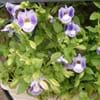Life Span
Annual
Perennial
Type
Flowering Plants, Shrubs
Fruit
Origin
Mexico, Central America
Eastern Asia
Types
African or American Marigolds, French Marigolds, Mule Marigolds
Actinidia arguta, Actinidia giraldii, Actinidia hypoleuca
Habitat
Roadsides, wastelands
Dappled Shade, open Woodlands
USDA Hardiness Zone
9-11
3-8
Sunset Zone
A1, A2, A3, H1, H2, 1a, 1b, 2a, 2b, 3a, 3b, 4, 5, 6, 7, 8, 9, 10, 11, 12, 13, 14, 15, 16, 17, 18, 19, 20, 21, 22, 23, 24
1a, 1b, 2a, 2b, 3a, 3b, 4, 5, 6, 7, 8, 9, 14, 15, 16, 17, 18, 19, 20
Habit
Upright/Erect
Vining/Climbing
Flower Color
Yellow, Orange, Gold, Ivory
White, Ivory
Flower Color Modifier
Bicolor
Bicolor
Fruit Color
Not Available
Green, Yellow green
Leaf Color in Spring
Dark Green
Green, Dark Green
Leaf Color in Summer
Dark Green
Dark Green
Leaf Color in Fall
Dark Green
Dark Green
Leaf Color in Winter
Light Green
Light Green
Plant Season
Summer, Fall
Spring, Summer, Fall
Sunlight
Full Sun
Full Sun, Partial Sun
Growth Rate
Very Fast
Medium
Type of Soil
Clay, Loam, Sand
Loam
The pH of Soil
Neutral, Alkaline
Neutral
Soil Drainage
Well drained
Well drained
Bloom Time
Indeterminate
Spring, Late Spring, Early Summer
Tolerances
Drought
Shade areas
Where to Plant?
Container, Ground, Pot
Ground, Pot
How to Plant?
Seedlings
Grafting, Stem Cutting
Plant Maintenance
Medium
Low
Watering Requirements
Allow to dry out slightly between watering
Average Water Needs, Requires regular watering
In Summer
Lots of watering
Regular watering required
In Spring
Moderate
Moderate
In Winter
Average Water
Average Water
Soil pH
Alkaline, Neutral
Neutral
Soil Type
Clay, Loam, Sand
Loam
Soil Drainage Capacity
Well drained
Well drained
Sun Exposure
Full Sun
Full Sun, Partial Sun
Pruning
Prune ocassionally, Remove dead or diseased plant parts, Requires little pruning
Remove damaged leaves, Remove dead branches, Remove dead leaves
Fertilizers
All-Purpose Liquid Fertilizer
Apply 10-10-10 amount, fertilize twice a year
Pests and Diseases
Alternaria Leaf Spot, Bacterial leaf spot, Damping-off, Gray mold, Powdery mildew, Root rot
Botrytis head rot, Japanese Beetles, Leaf Rollers, Nematodes, Phytophthora, Root rot, Sclerotinia blight, Spider mites, Thripes
Plant Tolerance
Drought
Shade areas
Flower Petal Number
Single, Double, Semi-Double
Single
Fragrant Bark/Stem
Yes
No
Foliage Texture
Coarse
Medium
Foliage Sheen
Matte
Glossy
Attracts
Butterflies
Cats
Allergy
Not Available
Not Available
Aesthetic Uses
Showy Purposes
Cottage Garden
Beauty Benefits
Not Available
Not Available
Environmental Uses
Air purification
Shadow Tree
Medicinal Uses
Burns, constipation, Inflammation, Upset stomach, Wounds
Antioxidants, Fiber, Folate, Rich in Potassium, Vitamin C
Part of Plant Used
Flowers, Seeds
Fruits
Other Uses
Can be made into a herbal tea, Decoration Purposes, Used As Food
Grown for shade
Used As Indoor Plant
Yes
No
Used As Outdoor Plant
Yes
Yes
Garden Design
Flower borders
Edible, Feature Plant, Vine
Botanical Name
Tagetes lucida
ACTINIDIA arguta
Common Name
sweetscented marigold, Mexican marigold
Hardy Kiwi
In Hindi
sweetscented marigold
हार्डी कीवी
In German
süß duftend Ringelblume
Hardy Kiwi
In Spanish
pericón, Santa María, yerbanís
kiwi hardy
In Greek
γλυκό άρωμα κατιφέ
σκληραγωγημένα ακτινίδια
In Portuguese
Tarragon Mexicano
kiwi Hardy
In Polish
słodkie pachnące nagietka
hardy kiwi
In Latin
sweetscented marigold
Hardy kiwi
Phylum
Tracheophyta
Magnoliophyta
Class
Magnoliopsida
Magnoliopsida
Family
Asteraceae
Actinidiaceae
Clade
Not Available
Angiosperms, Asterids, Eudicots
Tribe
Not Available
Not Available
Subfamily
Not Available
Actinidiaceae
Number of Species
Not Available
Importance of Sweetscented Marigold and Hardy Kiwi
Want to have the most appropriate plant for your garden? You might want to know the importance of Sweetscented Marigold and Hardy Kiwi. Basically, these two plants vary in many aspects. Compare Sweetscented Marigold and Hardy Kiwi as they differ in many characteristics such as their life, care, benefits, facts, etc. Every gardener must at least have the slightest clue about the plants he wants to plant in his garden. Compare their benefits, which differ in many ways like facts and uses. The medicinal use of Sweetscented Marigold is Burns, constipation, Inflammation, Upset stomach and Wounds whereas of Hardy Kiwi is Antioxidants, Fiber, Folate, Rich in Potassium and Vitamin C. Sweetscented Marigold has beauty benefits as follows: Not Available while Hardy Kiwi has beauty benefits as follows: Not Available.
Compare Facts of Sweetscented Marigold vs Hardy Kiwi
How to choose the best garden plant for your garden depending upon its facts? Here garden plant comparison will help you to solve this query. Compare the facts of Sweetscented Marigold vs Hardy Kiwi and know which one to choose. As garden plants have benefits and other uses, allergy is also a major drawback of plants for some people. Allergic reactions of Sweetscented Marigold are Not Available whereas of Hardy Kiwi have Not Available respectively. Having a fruit bearing plant in your garden can be a plus point of your garden. Sweetscented Marigold has no showy fruits and Hardy Kiwi has no showy fruits. Also Sweetscented Marigold is not flowering and Hardy Kiwi is not flowering . You can compare Sweetscented Marigold and Hardy Kiwi facts and facts of other plants too.
